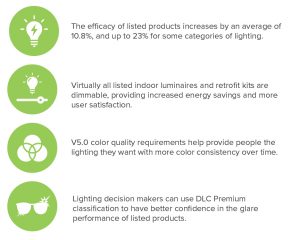This website uses cookies so that we can provide you with the best user experience possible. Cookie information is stored in your browser and performs functions such as recognising you when you return to our website and helping our team to understand which sections of the website you find most interesting and useful.
The V5.0 and V5.1 revisions to the SSL Technical Requirements are the first of a series of V5 specifications designed to improve the quality of light and connectivity of DLC listed products. As a whole, V5’s phased approach to incorporating quality of light and controllability metrics on the QPL will help ensure only high-quality products are listed, superior performing products can be differentiated, and additional energy savings are realized.
The initial draft Technical Requirements V5.0 laid out the DLC’s broad vision for improving the quality of light and controllability of products on the SSL QPL. Current and future Technical Requirements releases in the V5 program focus on implementing these requirements on a timeline that aligns with industry development cycles and current research.
Long-Term Goals of the V5 Program
- Differentiate lighting with a focus on health and wellness that can provide comfortable, safe environments for people.
- Increase lighting controls adoption to better realize energy savings and enable improved quality of light.
- Ensure persistent energy savings through increases in efficacy and enhanced user experience with DLC qualified lighting.
- Make more product data available for lighting decision-makers.
Goals of Version 5.0

V5.0 Focus Areas
The DLC will address three main focus areas with V5.0 to achieve the goals of the V5 program.
-

Efficacy Increase
Version 5.0 of the Technical Requirements is designed to balance the trade-offs between efficacy, quality of light related to performance and wellbeing, and cost considerations of lighting products on the QPL. Quality of light must go hand-in-hand with energy efficiency if long-term energy savings are to be realized.
Objective: Increase the minimum efficacy requirements for listing on the QPL without sacrificing quality of light of listed products.
-

Controllability of Light
Controllability refers to the capability to control a light source by dimming it; turning it off or on in response to a sensor or signal; or changing the color (or spectrum) of light over time to mimic sunlight, among others. Increased controllability of lighting can save more energy and provide higher quality of light by enabling the ability to tune lighting to just what is needed or preferred for a person, task, or application.
Objective: Increase lighting controls adoption to better realize energy savings and improved quality of light.
-

Quality of Light
Quality of light describes the aspects of light that impact productivity, performance, comfort, aesthetics, mood, safety, health, and wellbeing. Lighting that provides comfortable, safe environments for people is critical, leading to wider adoption and persistent energy savings.
The DLC is providing information about the quality of light properties of listed products in its proposed Technical Requirements V5.0 for the following topics. Click the green info buttons to learn more.
Objective: Improve the quality of light in the built environment, helping to ensure safe, comfortable, and productive settings for people, mitigating negative impacts of electrical light, and realizing lasting energy savings.
V5.0 and V5.1 Drafts and Documents
Final Draft Documents
- SSL Technical Requirements V5.0
- SSL Technical Requirements V5.1
- V5.0 & V5.1 Manufacturer and Industry Guidance
Second Draft Documents
- Executive Summary: DRAFT 2 SSL Technical Requirements V5.0
- DRAFT 2 SSL Technical Requirements V5.0
- Comment Form: DRAFT 2 SSL Technical Requirements V5.0 Comment Form
First Draft Documents
© 2023 DesignLights Consortium. The DesignLights Consortium is a project of Efficiency Forward, Inc., a non-profit 501(c)3 organization. Privacy Policy Terms of Use
